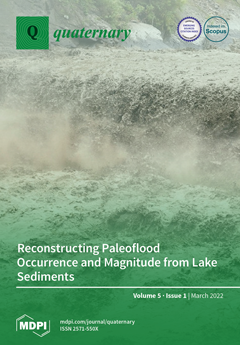Radiocarbon-dated peat cores collected from an ombrotrophic bog in southern Estonia record shifting environmental conditions and carbon accumulation rates in northern Europe during the late Holocene. Modern observations indicate that the water balance of the peatland is highly influenced by changes in relative humidity, followed by temperature and precipitation. The modern δ
18O and δ
2H values of surface water suggest that the groundwater is an integration of several months of precipitation. There also appears to be little or no direct influence of surface evaporation on the water within the bog, suggesting that water loss is preferentially through transpiration and sub-surface flow. Bulk peat δ
13C values exhibit a trend of higher values through the late Holocene, suggesting a pattern of overall increased surface wetness. The δ
15N values were low from ~4130 to 3645 cal yr BP, suggesting drier conditions, followed by intermediate values until ~2995 cal yr BP. The δ
15N values decrease again from ~2995 to 2470 cal yr BP, suggesting a return to drier conditions, followed by intermediate values until ~955 cal yr BP. The δ
15N values were high, suggesting wetter conditions from ~955 to 250 cal yr BP, followed by intermediate values through the modern. Carbon accumulation rates were low to intermediate from ~4200 to 2470 cal yr BP, followed by intermediate-to-high values until ~1645 cal yr BP. Carbon accumulation rates were then low until ~585 cal yr BP, followed by intermediate values through the modern. The geochemical data, combined with observed changes in peat composition and regional proxies of temperature and water table fluctuations through the late Holocene, suggest that carbon accumulation rates were relatively low under dry and warm conditions, whereas accumulation was generally higher (up to ~80 g C m
−2 yr
−1) when the climate was wetter and/or colder. These findings further suggest that future environmental changes affecting the regional water balance and temperature will impact the potential for northern peatlands to capture and store carbon.
Full article





